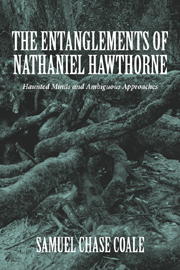Book contents
- Frontmatter
- Contents
- Acknowledgments
- List of Abbreviations
- Introduction: Entanglements
- 1 The Legacy of The Scarlet Letter: Hawthorne in Contemporary Culture
- 2 Hawthorne as Nineteenth-Century Morbid Genius
- 3 Biographical and Critical Veils in the Nineteenth Century
- 4 Biographical Visions of the Twentieth Century
- 5 Entangled Polarities: The New Criticism
- 6 Doubting Dualisms: The Strategies of Hawthorne's Romance
- 7 Ideological Contexts: Deconstruction, Feminism, the New Historicism, Race, and Entanglement
- Works Cited
- Index
2 - Hawthorne as Nineteenth-Century Morbid Genius
Published online by Cambridge University Press: 12 September 2012
- Frontmatter
- Contents
- Acknowledgments
- List of Abbreviations
- Introduction: Entanglements
- 1 The Legacy of The Scarlet Letter: Hawthorne in Contemporary Culture
- 2 Hawthorne as Nineteenth-Century Morbid Genius
- 3 Biographical and Critical Veils in the Nineteenth Century
- 4 Biographical Visions of the Twentieth Century
- 5 Entangled Polarities: The New Criticism
- 6 Doubting Dualisms: The Strategies of Hawthorne's Romance
- 7 Ideological Contexts: Deconstruction, Feminism, the New Historicism, Race, and Entanglement
- Works Cited
- Index
Summary
Despite radical changes in American culture and society since Hawthorne's day, he has managed to remain at the top of the list of American literature's classic writers. In fact over the years he has never been displaced. Through psychological criticism and the study of symbols, myth criticism and deconstruction, linguistic, Marxist and feminist analysis, he has managed to stay in place in the American canon. Jane Tompkins tried in 1985 to undermine his position or at least expose it as the result of a cabal led by the champions of Dead White Males and New England elitists to keep him in the forefront of the concept of a newly emerging American literature in the 1850s and beyond:
The prominence of Hawthorne's texts in the post–Civil War era is a natural consequence of his relation to the mechanisms that produced literary and cultural opinion. Hawthorne's initial connections with the Boston literati — his acquaintance with Longfellow at college, his residence next door to Alcott and a half mile from Emerson (his son and Emerson's nephew roomed together at Harvard), his marrying a Peabody, becoming fast friends with Ticknor and Lowell, being published by the indefatigable Fields, socializing with Duyckinck and Whipple — these circumstances positioned Hawthorne's literary production so that it became the property of a dynastic cultural elite which came to identify itself with him … In short, the friends and associates who outlived Hawthorne kept his fiction up-to-date by writing about it, and then their friends took over. (29–30)
- Type
- Chapter
- Information
- The Entanglements of Nathaniel HawthorneHaunted Minds and Ambiguous Approaches, pp. 20 - 42Publisher: Boydell & BrewerPrint publication year: 2011



